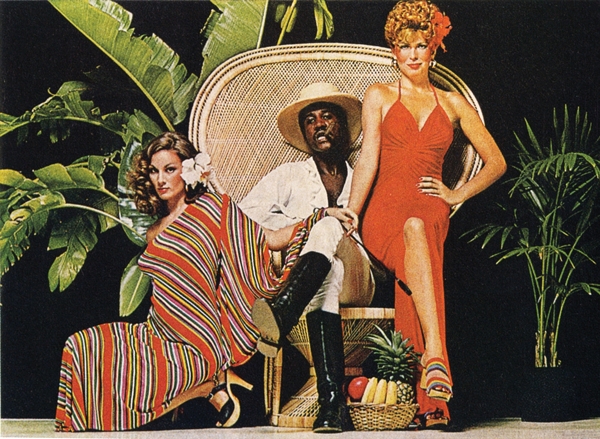Hank Willis Thomas
We asked Hank Willis Thomas to tell us about a picture that meant something to him, and why. Thomas’s exhibition Unbranded: A Century of White Women, 1915-2015 is at Jack Shainman Gallery through May 23.
What does an ad look like naked? I first came across this image in a book about 1970s era advertisements. I was immediately struck by the provocativeness of the image for the time. It is reminiscent of the iconic photograph of Black Panther leader Huey P. Newton taken just a few years earlier. The handsome, dapper African American man is dressed for a safari and holds a whip in his lap. The women sit on either side of his throne like proud concubines.
Wasn’t this just six years after the assassination of Martin Luther King, Jr.? Weren’t interracial unions still illegal in many states? Could an ad like this have existed ten years prior? If not, what had changed? Was it Civil Rights? Black Power? Blaxploitation films? Or was this just ordinary life? What was this an ad for anyway?
Then I read the ad copy: “Are you the right kind of woman for it? The Mistress Collection by Funky.” This was an ad for dresses? I was perplexed, offended, and amused. It seemed that exotic tropes and references to savage “jungle love” were being employed to sell dresses to upper income “White” women who weren’t afraid to take a walk on the wild side. There were so many assumptions that had to be made about race and gender in order for that image to make sense in an advertisement for women’s attire. If it weren’t for the text, the average viewer would probably be lost. It made me wonder about what would happen if I blew it up, removed the text, and presented it as a work of art. This was one of the inspirations for my project Unbranded: Reflections in Black by Corporate America 1968-2008. I realized that ad images rarely have anything to do with the products they’re selling, and by removing the text, the ulterior motives of the advertisers are revealed. It also says so much about bodies as signifiers of value and virtue. We find racist, sexist, and ageist messages being transmitted. I see ephemera of popular culture as potent material for making art about the past and the present.


No comments:
Post a Comment